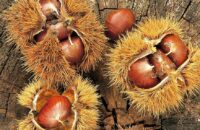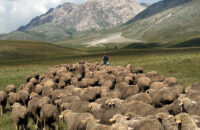Christmas is less and less to go, and the kitchens of Abruzzo grandmothers are beginning to get dirty with flour, eggs and chocolate. It is not uncommon, in fact, to find homes buzzing with the preparation of what have become the typical sweets of the Christmas tradition. In our minds, every Christmas dessert is linked to a memory, more or less recent, and it is precisely to evoke the tradition that we cannot do without them and do not want to have them missing from our table every year. In Abruzzo there is a rich list, we propose the five best known and most characteristic of the region:
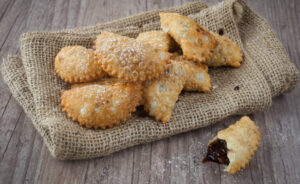 Calcionetti: these are Christmas sweets typical of Abruzzo cuisine. They are fried ravioli with a very light dough that contain inside a filling of chestnuts, grape jam, cooked must, walnuts, almonds, dark chocolate and various flavorings. In particular, in the Theatine area they are filled with chickpeas, in L’Aquila they are prepared with almonds, while in Teramo they are filled with chestnut cream. Although there are many variations of them, with the filling varying from city to city and the name varying according to the place of production, the shape of these tasty sweets always remains the same. Today each family has its own recipe, a story to be preserved and passed down through time.
Calcionetti: these are Christmas sweets typical of Abruzzo cuisine. They are fried ravioli with a very light dough that contain inside a filling of chestnuts, grape jam, cooked must, walnuts, almonds, dark chocolate and various flavorings. In particular, in the Theatine area they are filled with chickpeas, in L’Aquila they are prepared with almonds, while in Teramo they are filled with chestnut cream. Although there are many variations of them, with the filling varying from city to city and the name varying according to the place of production, the shape of these tasty sweets always remains the same. Today each family has its own recipe, a story to be preserved and passed down through time.
Soffioni: these are a dessert that is prepared throughout the region and, because of this, has numerous variations, even savory ones. Typically, however, this sweet pie is made of a pastry very similar to shortcrust pastry, prepared with oil instead of butter, and contains a mouth-watering filling of cheese (usually sheep’s milk ricotta is used) and eggs.
Bocconotti: The origins of this dessert date back to the 700s when a maid, to pay homage to her master, invented a dessert that resembled a coffee cup: short pastry filled with liquid coffee and chocolate. After the first baking, she decided to thicken the filling with almonds and egg yolks and cover the “little cup” with a lid, which she dusted with powdered sugar when it was cooked. The woman improvised the name of the dessert into “Bocconotto” since it was eaten in one bite. Over the years the filling has been enriched with grape jam, plum jam, apricot jam, walnuts, almonds, marsala and embodies the essence of Abruzzo craftsmanship.
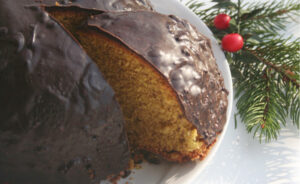 Parrozzo: The name originally was Pan Rozzo and it was first prepared in Pescara in 1920 by Luigi D’Amico who, inspired by the shapes and colors of a rough bread, reproduced the yellow of the corn with that of the eggs (to which he added almond flour) and the dark color given by the burning of the crust of the bread baked in the oven, with the dark chocolate coating. The first person to taste this new creation was the poet Gabriele d’Annunzio, who wrote a madrigal for it:
Parrozzo: The name originally was Pan Rozzo and it was first prepared in Pescara in 1920 by Luigi D’Amico who, inspired by the shapes and colors of a rough bread, reproduced the yellow of the corn with that of the eggs (to which he added almond flour) and the dark color given by the burning of the crust of the bread baked in the oven, with the dark chocolate coating. The first person to taste this new creation was the poet Gabriele d’Annunzio, who wrote a madrigal for it:
“It’s so ‘good’ this parish nine that it seems to be the madness of San Ciatté.”
In its dough it is easy to find most of the ingredients most commonly used in Abruzzi cuisine: flour, eggs, sugar, almonds, chocolate, grated lemon and orange.
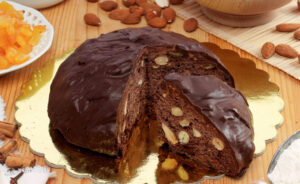 Pan dell’Orso: a variant to the traditional Parrozzo, produced in the Scanno area, which differs in preparation by the addition of honey and butter to give more softness to the dough. The shape of this cake is reminiscent of the small breads shepherds used to bring during transhumance and is a tribute to the king of animals in the mountainous area where it is produced.
Pan dell’Orso: a variant to the traditional Parrozzo, produced in the Scanno area, which differs in preparation by the addition of honey and butter to give more softness to the dough. The shape of this cake is reminiscent of the small breads shepherds used to bring during transhumance and is a tribute to the king of animals in the mountainous area where it is produced.
Mostaccioli: made with cooked must, flour, honey, almonds, cocoa and a of chocolate frosting, these diamond-shaped sweets are said to have originated in Naples, but have become an integral part of Abruzzo’s Christmas tradition.
Torcinelli: typical fried sweets, not to be confused with the meat dish of the same name, are very simple to prepare, thanks to a dough made mainly of potatoes covered in sugar. They owe their name, in dialect turcinell’, to their elongated and twisted shape.
Pepatelli: typical of the Teramo area but widespread as far as Molise, these are cookies made with almonds, honey and pepper, the characteristic ingredient from which they derive their name.
In Rome, on the other hand, there are two desserts in particular that stand out and distinguish the Christmas season:
Panpepato: it is the king of the Roman Christmas table. It is a circular-shaped cake made with dried fruit, hazelnuts, honey, orange peel, candied fruit, cocoa and pepper, an unfailing ingredient in the dough, which gives it an unmistakable spicy note.
Pangiallo: a cake prepared as early as the ancient Romans on the winter solstice as an auspicious sign to celebrate the rebirth of the sun. This is a fragrant and tasty loaf that gets its name from the yellow saffron glaze that covers it; in dough it is similar to gingerbread, but decidedly sweeter.
Then from the rich tradition of Tuscia come the Tozzetti Viterbesi, cookies made with hazelnuts from the Cimini Mountains, to be enjoyed at the end of a meal, or the Pan del Vescovo, a cake filled with dried fruit, hazelnuts, walnuts, raisins, dried figs and even dark chocolate. Finally, on the Christmas table cannot miss Ciociaria, with its Torroncini di Alvito, made with almonds, hazelnuts, honey, caramelized sugar and dark chocolate, and Reatino, with Terzetti, typical holiday cookies made with nuts and honey.
Christmas sweets have great symbolic value in the popular imagination, and their traditionalist connotations, handed down through generations to the present day, are the best testimony to this. Their virtue goes far beyond mere taste, for they manage to evoke in each of us memories, smells and emotions to which we remain strongly attached so much so that we are enthusiastic about continuing to pass them on and reenact them every year.





